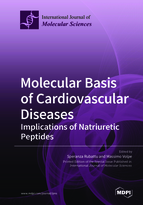Molecular Basis of Cardiovascular Diseases: Implications of Natriuretic Peptides
A special issue of International Journal of Molecular Sciences (ISSN 1422-0067). This special issue belongs to the section "Molecular Pathology, Diagnostics, and Therapeutics".
Deadline for manuscript submissions: closed (30 June 2019) | Viewed by 102762
Special Issue Editors
2. Department of Clinical and Molecular Medicine, School of Medicine and Psychology, Sapienza University, 00185 Rome, Italy
Interests: cardiovascular medicine
Special Issues, Collections and Topics in MDPI journals
Interests: hypertension; heart failure; neurohormonal systems; cardiovascular prevention
Special Issues, Collections and Topics in MDPI journals
Special Issue Information
Dear Colleagues,
The natriuretic peptides (NPs) family includes a class of hormones and their receptors needed for the physiological control of cardiovascular functions. The discovery of NPs provided a fundamental contribution into our understanding of the physiological regulation of blood pressure, of heart and kidney functions. NPs have also been implicated in the pathogenesis of several cardiovascular diseases (CVDs), including hypertension, atherosclerosis, heart failure and stroke. A fine comprehension of the molecular mechanisms dependent from NPs and underlying the promotion of cardiovascular damage has contributed to improve our understanding of the molecular basis of all major CVDs. Finally, the opportunity to target NPs in order to develop new therapeutic tools for a better treatment of CVDs has been developed over the years.
This Special Issue will cover all major aspects of the molecular implications of NPs in physiology and pathology of the cardiovascular system, including natriuretic peptide-based therapeutic approaches.
Dr. Speranza Rubattu
Dr. Massimo Volpe
Guest Editors
Manuscript Submission Information
Manuscripts should be submitted online at www.mdpi.com by registering and logging in to this website. Once you are registered, click here to go to the submission form. Manuscripts can be submitted until the deadline. All submissions that pass pre-check are peer-reviewed. Accepted papers will be published continuously in the journal (as soon as accepted) and will be listed together on the special issue website. Research articles, review articles as well as short communications are invited. For planned papers, a title and short abstract (about 100 words) can be sent to the Editorial Office for announcement on this website.
Submitted manuscripts should not have been published previously, nor be under consideration for publication elsewhere (except conference proceedings papers). All manuscripts are thoroughly refereed through a single-blind peer-review process. A guide for authors and other relevant information for submission of manuscripts is available on the Instructions for Authors page. International Journal of Molecular Sciences is an international peer-reviewed open access semimonthly journal published by MDPI.
Please visit the Instructions for Authors page before submitting a manuscript. There is an Article Processing Charge (APC) for publication in this open access journal. For details about the APC please see here. Submitted papers should be well formatted and use good English. Authors may use MDPI's English editing service prior to publication or during author revisions.







